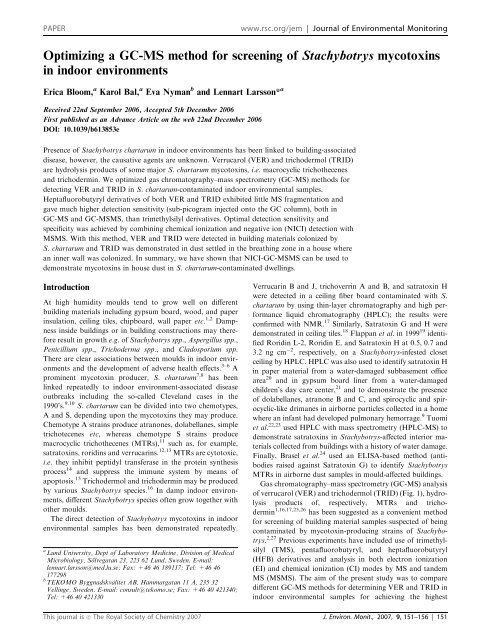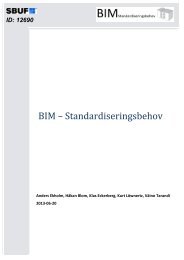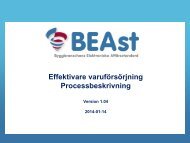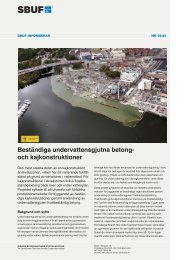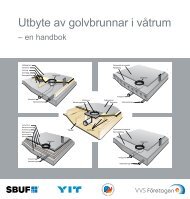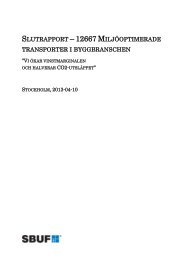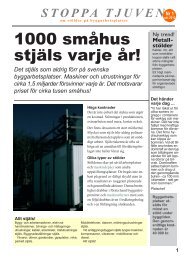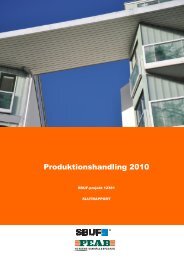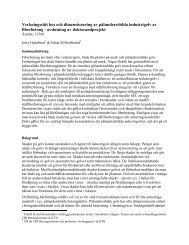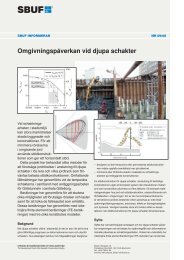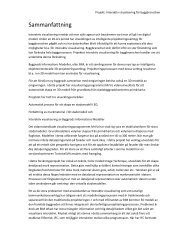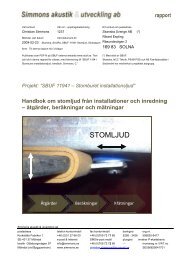Rapport SBUF-projekt: Mykotoxiner i inomhusmiljöer. Förekomst ...
Rapport SBUF-projekt: Mykotoxiner i inomhusmiljöer. Förekomst ...
Rapport SBUF-projekt: Mykotoxiner i inomhusmiljöer. Förekomst ...
You also want an ePaper? Increase the reach of your titles
YUMPU automatically turns print PDFs into web optimized ePapers that Google loves.
PAPER www.rsc.org/jem | Journal of Environmental Monitoring<br />
Optimizing a GC-MS method for screening of Stachybotrys mycotoxins<br />
in indoor environments<br />
Erica Bloom, a Karol Bal, a Eva Nyman b and Lennart Larsson* a<br />
Received 22nd September 2006, Accepted 5th December 2006<br />
First published as an Advance Article on the web 22nd December 2006<br />
DOI: 10.1039/b613853e<br />
Presence of Stachybotrys chartarum in indoor environments has been linked to building-associated<br />
disease, however, the causative agents are unknown. Verrucarol (VER) and trichodermol (TRID)<br />
are hydrolysis products of some major S. chartarum mycotoxins, i.e. macrocyclic trichothecenes<br />
and trichodermin. We optimized gas chromatography–mass spectrometry (GC-MS) methods for<br />
detecting VER and TRID in S. chartarum-contaminated indoor environmental samples.<br />
Heptafluorobutyryl derivatives of both VER and TRID exhibited little MS fragmentation and<br />
gave much higher detection sensitivity (sub-picogram injected onto the GC column), both in<br />
GC-MS and GC-MSMS, than trimethylsilyl derivatives. Optimal detection sensitivity and<br />
specificity was achieved by combining chemical ionization and negative ion (NICI) detection with<br />
MSMS. With this method, VER and TRID were detected in building materials colonized by<br />
S. chartarum and TRID was demonstrated in dust settled in the breathing zone in a house where<br />
an inner wall was colonized. In summary, we have shown that NICI-GC-MSMS can be used to<br />
demonstrate mycotoxins in house dust in S. chartarum-contaminated dwellings.<br />
Introduction<br />
At high humidity moulds tend to grow well on different<br />
building materials including gypsum board, wood, and paper<br />
insulation, ceiling tiles, chipboard, wall paper etc. 1,2 Dampness<br />
inside buildings or in building constructions may therefore<br />
result in growth e.g. of Stachybotrys spp., Aspergillus spp.,<br />
Penicillium spp., Trichoderma spp., and Cladosporium spp.<br />
There are clear associations between moulds in indoor environments<br />
and the development of adverse health effects. 3–6 A<br />
prominent mycotoxin producer, S. chartarum 7,8 has been<br />
linked repeatedly to indoor environment-associated disease<br />
outbreaks including the so-called Cleveland cases in the<br />
1990’s. 9,10 S. chartarum can be divided into two chemotypes,<br />
A and S, depending upon the mycotoxins they may produce.<br />
Chemotype A strains produce atranones, dolabellanes, simple<br />
trichotecenes etc, whereas chemotype S strains produce<br />
macrocyclic trichothecenes (MTRs), 11 such as, for example,<br />
satratoxins, roridins and verrucarins. 12,13 MTRs are cytotoxic,<br />
i.e. they inhibit peptidyl transferase in the protein synthesis<br />
process 14 and suppress the immune system by means of<br />
apoptosis. 15 Trichodermol and trichodermin may be produced<br />
by various Stachybotrys species. 16 In damp indoor environments,<br />
different Stachybotrys species often grow together with<br />
other moulds.<br />
The direct detection of Stachybotrys mycotoxins in indoor<br />
environmental samples has been demonstrated repeatedly.<br />
a Lund University, Dept of Laboratory Medicine, Division of Medical<br />
Microbiology, So¨lvegatan 23, 223 62 Lund, Sweden. E-mail:<br />
lennart.larsson@med.lu.se; Fax: +46 46 189117; Tel: +46 46<br />
177298<br />
b TEKOMO Byggnadskvalitet AB, Hammargatan 11 A, 235 32<br />
Vellinge, Sweden. E-mail: consult@tekomo.se; Fax: +46 40 421340;<br />
Tel: +46 40 421330<br />
Verrucarin B and J, trichoverrin A and B, and satratoxin H<br />
were detected in a ceiling fiber board contaminated with S.<br />
chartarum by using thin-layer chromatography and high performance<br />
liquid chromatography (HPLC); the results were<br />
confirmed with NMR. 17 Similarly, Satratoxin G and H were<br />
demonstrated in ceiling tiles. 18 Flappan et al. in 1999 19 identified<br />
Roridin L-2, Roridin E, and Satratoxin H at 0.5, 0.7 and<br />
3.2 ng cm 2 , respectively, on a Stachybotrys-infested closet<br />
ceiling by HPLC. HPLC was also used to identify satratoxin H<br />
in paper material from a water-damaged subbasement office<br />
area 20 and in gypsum board liner from a water-damaged<br />
children’s day care center, 21 and to demonstrate the presence<br />
of dolabellanes, atranone B and C, and spirocyclic and spirocyclic-like<br />
drimanes in airborne particles collected in a home<br />
where an infant had developed pulmonary hemorrage. 9 Tuomi<br />
et al. 22,23 used HPLC with mass spectrometry (HPLC-MS) to<br />
demonstrate satratoxins in Stachybotrys-affected interior materials<br />
collected from buildings with a history of water damage.<br />
Finally, Brasel et al. 24 used an ELISA-based method (antibodies<br />
raised against Satratoxin G) to identify Stachybotrys<br />
MTRs in airborne dust samples in mould-affected buildings.<br />
Gas chromatography–mass spectrometry (GC-MS) analysis<br />
of verrucarol (VER) and trichodermol (TRID) (Fig. 1), hydrolysis<br />
products of, respectively, MTRs and trichodermin<br />
1,16,17,25,26 has been suggested as a convenient method<br />
for screening of building material samples suspected of being<br />
contaminated by mycotoxin-producing strains of Stachybotrys.<br />
2,27 Previous experiments have included use of trimethylsilyl<br />
(TMS), pentafluorobutyryl, and heptafluorobutyryl<br />
(HFB) derivatives and analysis in both electron ionization<br />
(EI) and chemical ionization (CI) modes by MS and tandem<br />
MS (MSMS). The aim of the present study was to compare<br />
different GC-MS methods for determining VER and TRID in<br />
indoor environmental samples for achieving the highest<br />
This journal is c The Royal Society of Chemistry 2007 J. Environ. Monit., 2007, 9, 151–156 | 151


